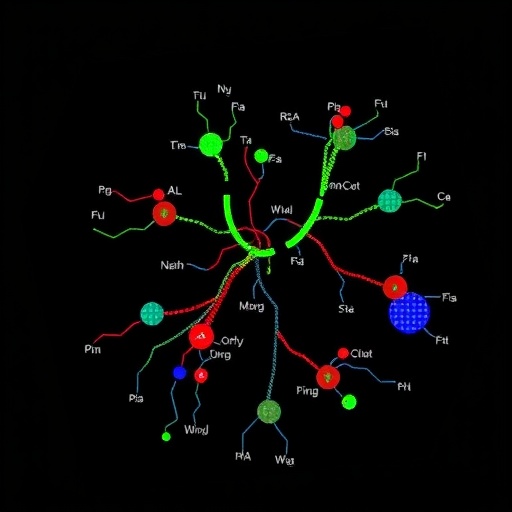In a groundbreaking study published in BMC Cancer, researchers have unveiled critical molecular interactions underlying the progression of cervical cancer, shining light on new potential therapeutic avenues. The study elucidates how the long non-coding RNA (LncRNA) SNHG15 exerts profound influence on cervical cancer cell proliferation, apoptosis, migration, and invasion through its targeting of microRNA miR-200a-3p. This discovery adds a significant layer of understanding to the complex molecular crosstalk driving cervical cancer pathophysiology.
Cervical cancer remains a leading cause of mortality among women globally, particularly in China, where incidence and death rates from this malignancy eclipse those of other female reproductive tract cancers. Despite advances in screening and vaccination, cervical cancer continues to present daunting challenges, partly due to its molecular heterogeneity and capacity for aggressive progression. Against this backdrop, the identification of novel molecular regulators such as SNHG15 and miR-200a-3p is of profound clinical importance.
The investigators began their research by evaluating expression patterns of SNHG15 in various cell lines, including human cervical immortalized squamous cells (Ect1/E6E7) and multiple cervical cancer cell lines such as SiHa, HeLa, Caski, and C-33 A. Using quantitative reverse transcription PCR (qRT-PCR), they observed that SNHG15 expression was markedly elevated in the cancerous lines compared to the immortalized normal control cells. Among these, HeLa and SiHa cells exhibited the most significant overexpression, making them prime models for subsequent functional experiments.
.adsslot_Psf3ekXILq{ width:728px !important; height:90px !important; }
@media (max-width:1199px) { .adsslot_Psf3ekXILq{ width:468px !important; height:60px !important; } }
@media (max-width:767px) { .adsslot_Psf3ekXILq{ width:320px !important; height:50px !important; } }
ADVERTISEMENT
Given the emerging role of microRNAs (miRNAs) as critical post-transcriptional regulators in cancer, the research team investigated whether SNHG15 interacts with miRNAs to exert its effects. miR-200a-3p, a miRNA previously implicated in tumor suppression and modulation of epithelial-to-mesenchymal transition, was found to be inversely correlated with SNHG15 expression in cervical cancer cells. Dual luciferase reporter assays demonstrated direct binding between SNHG15 and miR-200a-3p, identifying a regulatory axis where SNHG15 acts as a competing endogenous RNA (ceRNA), sequestering miR-200a-3p and thereby modulating its downstream targets.
This SNHG15-miR-200a-3p interaction has significant implications for cervical cancer biology. By sponging miR-200a-3p, SNHG15 effectively releases the brakes on pathways that foster tumor cell proliferation and metastatic potential. Conversely, downregulation of miR-200a-3p directly enhanced malignant traits similar to those triggered by SNHG15 overexpression, confirming the axis as a pivotal modulator of tumor aggressiveness.
Cellular assays including the CCK8 proliferation test, as well as migration and invasion assays, corroborated these molecular findings with functional evidence. Cells with high SNHG15 and low miR-200a-3p levels exhibited robust growth and invasiveness, key features that contribute to cervical cancer progression and poor clinical outcomes. These in vitro results provide a compelling rationale to explore this RNA axis as a therapeutic target.
At the mechanistic level, the study adds to the growing body of literature positioning long non-coding RNAs as master regulators in cancer through their ability to modulate microRNA activity. SNHG15 appears to fit this paradigm, serving not only as a molecular sponge but potentially influencing epigenetic and signaling networks that drive oncogenesis. The intricate balance between oncogenic lncRNAs and tumor suppressive miRNAs thus emerges as a crucial battlefield in cancer biology.
The demonstrated capacity of SNHG15 to influence apoptosis was also touched upon in the research, though detailed mechanistic pathways remain to be fully elucidated. The modulation of apoptotic pathways by non-coding RNAs often involves cross-talk with key signaling hubs like p53, Bcl-2 family members, and caspases, and future studies will be pivotal in mapping these interactions in the context of SNHG15 and miR-200a-3p.
This study’s retrospective trial registration underscores the clinical relevance and timely nature of the research. The findings pave the way for translational approaches that could harness SNHG15 or miR-200a-3p modulation to impair cervical cancer growth and dissemination, offering hope for improved patient outcomes.
Indeed, targeting lncRNAs therapeutically has emerged as a promising frontier, albeit one with significant delivery and specificity challenges. The identification of SNHG15 as a nodal player opens potential strategies, including antisense oligonucleotides or small molecules designed to disrupt its interaction with miR-200a-3p or associated protein complexes.
Moreover, miR-200a-3p restoration represents an alternative therapeutic axis. Given its tumor suppressor role, strategies to elevate its expression or mimic its activity could counteract the oncogenic effects of SNHG15 overexpression. Such microRNA-based therapies have shown promise in preclinical models and some clinical trials across diverse cancer types.
The implications of this study extend beyond cervical cancer, as SNHG15 and miR-200a-3p have been implicated in other malignancies. The elucidation of their interplay may thus have broader relevance, potentially informing pan-cancer molecular targeting strategies.
In conclusion, this research not only highlights the pivotal role of the SNHG15-miR-200a-3p axis in cervical cancer cell malignancy but also contributes to the expanding understanding of non-coding RNA regulatory networks in cancer. As precision medicine advances, such molecular insights are essential for developing next-generation diagnostics and therapeutics tailored to disrupt cancer’s complex molecular circuitry.
Future work is needed to delineate the downstream gene targets modulated by the SNHG15-miR-200a-3p axis, to uncover the full spectrum of signaling pathways implicated. Additionally, in vivo studies and clinical validations will be critical to confirm the translational potential of these findings.
The evolving landscape of cervical cancer research thus welcomes SNHG15 as a novel and influential player. It reinforces the concept that targeting RNA molecules—once considered “junk”—is a powerful approach to alter cancer trajectories and improve survival outcomes.
As the field moves forward, integrating such molecular insights with existing treatment paradigms, including immunotherapy and chemotherapy, may offer synergistic benefits and personalized therapeutic options for patients battling cervical cancer worldwide.
Subject of Research: Molecular mechanisms underlying cervical cancer progression focusing on LncRNA SNHG15 and microRNA miR-200a-3p interaction.
Article Title: LncRNA SNHG15 targets miR-200a-3p affects the proliferation, apoptosis, migration, and invasion of cervical cancer cells.
Article References:
Han, S., Qin, Y., He, Y. et al. LncRNA SNHG15 targets miR-200a-3p affects the proliferation, apoptosis, migration, and invasion of cervical cancer cells. BMC Cancer 25, 1279 (2025). https://doi.org/10.1186/s12885-025-14600-3
Image Credits: Scienmag.com
DOI: https://doi.org/10.1186/s12885-025-14600-3
Tags: advances in cervical cancer treatmentcancer cell proliferation and apoptosiscervical cancer incidence and mortalitycervical cancer migration and invasioncervical cancer molecular interactionsexpression patterns of SNHG15innovative cancer research studiesLncRNA SNHG15 in cervical cancerlong non-coding RNA researchmolecular crosstalk in cancerrole of miR-200a-3p in cancer progressiontherapeutic targets for cervical cancer





